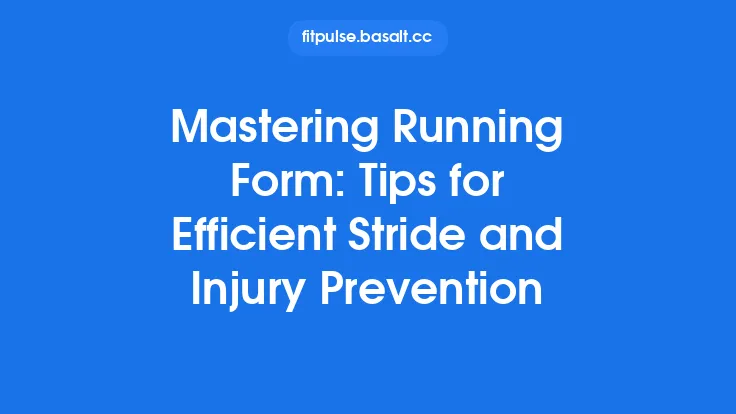Outdoor and park calisthenics offer a unique blend of freedom, creativity, and functional strength development. Yet, the very elements that make these workouts appealing—uneven terrain, variable equipment, and exposure to the elements—also introduce a higher risk of injury if proper precautions aren’t taken. Below is a comprehensive guide to safeguarding your body while you train in the open air, covering everything from biomechanical fundamentals to environmental awareness and recovery strategies.
Understanding the Mechanics of Injury
1. Load Distribution and Joint Alignment
Every calisthenic movement places stress on bones, ligaments, tendons, and muscles. When the line of force does not pass through the joint’s optimal axis, shear forces increase, leading to micro‑trauma. For example, a misaligned hand‑to‑shoulder position during a push‑up can overload the rotator cuff. Regularly assess your joint angles in a mirror or video to ensure that the load travels through the intended anatomical planes.
2. Repetitive Strain vs. Acute Trauma
In outdoor settings, injuries often arise from two sources:
- Repetitive strain (e.g., tendinopathy from excessive pull‑up volume)
- Acute events (e.g., a slip on a wet bench).
A balanced program must address both by incorporating adequate rest, varying movement patterns, and ensuring a safe training surface.
3. The Role of Core Stability
A strong, stable core acts as a “force transfer hub.” Weak core control forces the lumbar spine and hips to compensate, increasing the likelihood of lower‑back and hip injuries. Even though core‑specific sessions are covered elsewhere, maintaining baseline core engagement during every exercise is a non‑negotiable injury‑prevention principle.
Preparing the Environment
1. Surface Assessment
- Hard Concrete: Excellent for grip but unforgiving on falls. Use a high‑quality, shock‑absorbing mat for high‑impact moves (e.g., box jumps, plyometric push‑ups).
- Grass or Turf: Provides natural cushioning but can be uneven. Test for hidden divots or rocks that could cause ankle twists.
- Rubberized Playgrounds: Offer a good compromise—soft enough to reduce impact forces while still providing stable footing.
2. Equipment Inspection
Before each session, perform a quick visual and tactile check of any public apparatus:
- Bars: Look for rust, loose bolts, or splintered paint that could cause skin abrasions.
- Parallel Bars/Benches: Verify that they are level and free of cracks.
- Rope or Chains: Ensure they are not frayed and that knots are secure.
3. Weather and Lighting
- Rain or Dew: Increases slip risk. If the metal surfaces are wet, consider postponing high‑intensity work or using gloves with extra grip.
- Sun Exposure: Prolonged UV exposure can degrade skin and reduce proprioception due to sweating. Wear breathable, UV‑protective clothing and re‑apply sunscreen every two hours.
- Low Light: Shadows can mask hazards. Use a headlamp or choose well‑lit areas for evening sessions.
Optimizing Technique for Safety
1. Master the “Neutral Spine” Position
Across virtually every calisthenic movement, maintaining a neutral spine—natural lumbar curvature, engaged core, and aligned head—prevents excessive compressive forces on intervertebral discs. Practice this posture in front of a mirror until it becomes second nature.
2. Controlled Eccentric Phases
The lowering (eccentric) portion of a movement generates higher muscle tension than the concentric phase. Slowing this phase not only builds strength but also reduces the likelihood of sudden joint overload. Aim for a 2–3 second descent on pull‑ups, dips, and push‑ups.
3. Grip Variations and Hand Placement
Changing grip width or orientation distributes load across different muscle groups and joints, mitigating overuse. For instance, alternating between a neutral (palms facing each other) and pronated grip on bar work reduces repetitive stress on the wrist and forearm extensors.
4. Foot Placement and Balance
When performing exercises on uneven ground, keep your feet shoulder‑width apart and slightly flexed at the knees. This “ready stance” improves proprioceptive feedback and allows rapid corrective actions if the surface shifts.
Managing Training Load
1. Periodization Basics
Even in a park setting, structuring your training into macro‑cycles (monthly), meso‑cycles (weekly), and micro‑cycles (daily) helps prevent overtraining. Allocate at least one “deload” day per week where volume is reduced by 40–60 % and intensity is kept low.
2. Volume Tracking
Maintain a simple log of sets, reps, and difficulty (e.g., added weight, advanced lever). When you notice a 10 % increase in volume over two consecutive sessions, consider inserting a recovery day to avoid cumulative fatigue.
3. Auto‑Regulation Techniques
Use perceived exertion (RPE) or a simple “ready‑set‑go” scale to gauge daily readiness. If you score a 7 or higher on a 10‑point fatigue scale, scale back the session or focus on mobility work instead of high‑intensity strength.
Prehab and Mobility (Brief Overview)
While a dedicated warm‑up article exists, a quick reminder: incorporating dynamic joint circles (shoulder rolls, hip openers) and light activation drills (band pull‑aparts, scapular push‑ups) before heavy work primes the neuromuscular system and reduces injury risk. Keep these movements brief—2–3 minutes total—to avoid fatigue before the main workout.
Emergency Preparedness
1. First‑Aid Kit Essentials
- Adhesive bandages and sterile gauze
- Antiseptic wipes or spray
- Elastic wrap for sprains
- Instant cold pack (useful for sudden swelling)
- Tweezers (for splinters or debris)
2. Spotting and Partner Safety
When attempting high‑risk moves (e.g., muscle‑ups, handstand push‑ups), have a trained spotter positioned within arm’s reach. The spotter should be ready to support the body’s center of mass, not just catch a fall.
3. Communication Plan
If you train alone, let a friend or family member know your location and expected finish time. Carry a fully charged phone and consider a portable power bank for longer sessions.
Recovery Strategies Specific to Outdoor Training
1. Post‑Session Stretching
Static stretching after the workout helps reset muscle length and reduces delayed‑onset muscle soreness (DOMS). Focus on the major movers used: chest, shoulders, hip flexors, and calves.
2. Hydration and Electrolyte Balance
Even mild dehydration can impair proprioception and increase injury risk. Aim for 500 ml of water per hour of training, and supplement with electrolytes if you sweat heavily or train in hot climates.
3. Sleep Hygiene
Quality sleep (7–9 hours) is the cornerstone of tissue repair. If you train outdoors late in the evening, limit exposure to bright screens afterward to preserve melatonin production.
4. Active Recovery Options
Low‑intensity activities such as brisk walking, light cycling, or gentle yoga on a flat grass area promote blood flow without adding mechanical stress.
Monitoring and Adjusting Over Time
1. Regular Self‑Assessment
Every 4–6 weeks, perform a quick mobility and strength screen:
- Shoulder Flexibility: Wall slide test
- Hip Mobility: Deep squat depth
- Ankle Dorsiflexion: Knee‑to‑wall test
- Grip Strength: Hang time on a bar
Any regression signals a need to dial back intensity or incorporate targeted rehab work.
2. Professional Check‑Ins
If you notice persistent pain (especially in joints) lasting more than a week, consult a physiotherapist or sports medicine professional. Early intervention prevents minor issues from becoming chronic injuries.
Final Takeaway
Injury prevention for outdoor and park calisthenics is a multifaceted discipline that blends biomechanical awareness, environmental vigilance, smart programming, and diligent recovery. By systematically applying the principles outlined above—checking your training surface, maintaining impeccable technique, regulating load, and staying prepared for the unexpected—you can enjoy the freedom of open‑air training while keeping your body resilient and ready for continual progress.





